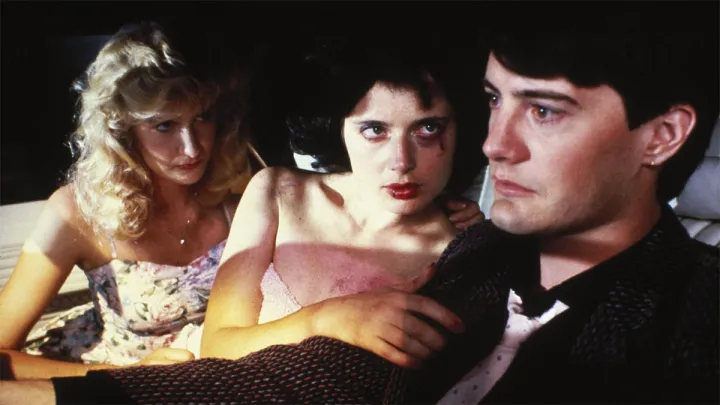We all know the vision: white picket fences, pastel-colored houses, green lawns, tall trees, mailboxes; children riding their bikes down the street, housewives wearing aprons and cooking pies, their delicious smell wafting out of the open window; husbands arriving late from work after a killer commute and struggling to keep a smile on their faces. This clear-cut, perfectly nauseating vision is pop culture’s eternal conception of the place that, throughout the years, has come to represent the ultimate American Dream: suburbia.
Don’t Worry Darling, Olivia Wilde’s psychological thriller starring Florence Pugh and, for some reason, Harry Styles, is the latest film terrified of but fascinated by suburbia. Taking place in the seemingly idyllic company town of Victory in California, the plot centers on Alice, a young housewife whose investigation into the origins of the utopian town and the company behind it leads to dark truths and dangerous secrets. The set-up sounds great, and It-Girl Pugh is there, so that’s certainly worth the trip to the cinema. However, Hollywood’s obsession with the dangers lurking beneath a seemingly perfect façade might be more interesting than Don’t Worry Darling‘s plot.
Suburbia has long been where some of Hollywood’s greatest minds come to play. To some — the Lynches and Carpenters of the world — suburbia has always been perverted, and their camera is just revealing the ugly truth. To others, the suburbs are alive, which means they have the potential for light and dark. This versatility is, perhaps, why we remain so intrigued by the suburbs’ potential to both enthrall and terrify us.
The suburbs are the ultimate contradiction; welcoming but wary of strangers, plain-looking on the outside but overly convoluted on the inside. They are the ultimate anesthetic, numbing the pain in some and suffocating the life out of others. Therein lies their allure because what’s scarier than a dream that can easily become a nightmare?
Settling down or just settling?

The fear of settling is a powerful and prevalent theme in cinema. If ambition drives most of humanity’s greatest discoveries, settling down is basically a white flag of surrender. It signals that our time to change the world and “make a difference” has come and gone, and we’ve become watchers, rather than players, in the game of life. There’s a reason why so many young people think of settling down as a prison made out of white picket fences. It’s a life sentence of tranquility, the price you should receive after running the race. But if you’re still running it, or you didn’t bother at all, what does it mean to move to the suburbs?
There’s a lingering vibe of frustration in our idea of the suburbs. It’s no wonder some of the most jarring dramas take place in perfect communities populated by people with unrealized potential, desperately trying to stay afloat while their shattered ambitions weigh them down. Think of American Beauty, Revolutionary Road, Ordinary People, Little Children, and The Virgin Suicides, stories that use broken promises, unfulfilled dreams, and unrealized intentions to explore our collective and broken psyche.
In a way, the suburbs are a collection of disappointed people struggling to maintain some semblance of happiness. Boomers and Gen X-ers might be the people we most closely associate with the derailed fantasy of suburbia; they basically scared future generations from ever wanting the misleading fantasy of suburban bliss.
Thus, the suburbs perpetually exist in a state of 1950s and ’60s Americana, forever frozen at a certain time and place, fixated on old-fashioned ideas that embrace tradition. Nostalgia thrives in the suburbs, adding to its lack of appeal; to Hollywood, entering the suburbs is like stepping into the past, when men were men, women were women, and things were simpler. Except, they weren’t.
There’s nothing worse than being normal

The suburbs invite normalcy; indeed, few settings are as homogenous as suburbia. At least in Hollywood’s imagination, these close-knit communities shun everyone that’s not white and good-looking, signaling them as undesirable and turning them into the dreaded other. These condemned figures make for wonderful protagonists because audiences will instantly relate to and root for them to bring down the establishment. Underdogs will always make for compelling heroes, and the heroes of suburbia are those who don’t fit in. Because on the big screen, there’s nothing worse than being normal.
Some of suburbia’s most unforgettable heroes are … different. In fact, for the lack of a better word, they are all-around freaks. Take Donnie Darko, Jake Gyllenhaal’s emotionally troubled teenager at the center of Richard Kelly’s sci-fi of the same name. Donnie firmly stands against the close-mindedness and outright stupidity of a town that preaches faith while protecting and enabling a child molester. His trauma and emotional turmoil don’t make him special, but his willingness to admit to them does. If the suburbs are all about pretending, the hero must be a paragon of self-awareness.
Tim Burton’s fantasy-romance Edward Scissorhands features one of cinema’s most iconic and loveable freaks. Taking the word in its most literal sense, Edward Scissorhands‘ hero is “strange” come to life. The fake and pastel-colored community around him first finds him fascinating, an exotic creature brought from the confinements of his Gothic mansion to mingle with the civilized people. In the suburbs, freaks always make people feel better about their boring selves. It isn’t long before the charms wear off, and the locals show their true colors, driving Edward back to his secluded manor, away from suburbia’s vibrant life but shielded from its worst devices.
Other films like Pleasantville and Welcome to the Dollhouse use different kinds of freaks to prove their anti-suburbia agenda. The former adopts a less direct and ultimately positive approach to its condemnation, but the latter goes all in on the cruelty lurking beneath suburbia’s pleasantness. The result is still the same, though, for freaks prevail against or, at least, successfully repel intolerance and stupidity. In this peculiar sub-genre, freaks are encouraged to let their flag fly; indeed, it might be their only way out of the crushing soporific of the suburbs.
Hiding in plain sight

In the otherwise awful 2004 remake of The Stepford Wives, while Glenn Close cheekily confesses her evil plot, she asks, “Where would people never notice a town full of robots? Connecticut!” There’s a reason suburbia is a favorite setting for thrillers and horror films, for who would ever think anything bad could happen behind these pristine doors? In fact, who would ever think anything could happen at all?
Like small-town America, suburbia has a … well, small-time quality to it. These communities are never too big; they’re large enough to support an ecosystem but still confined to only a select few who fit the bill. This delusion of passivity makes them prime candidates for harrowing stories exploring the darkest corners of the human psyche.
David Lynch’s neo-noir masterpiece Blue Velvet begins with the discovery of a severed human ear on a vacant lot. His timeless and surreal mystery series Twin Peaks features the disruption of a small town after the murder of Laura Palmer, the resident homecoming queen. Lynch expertly uses suspense and a distinctive ethereal, dream-like quality to expose the ugliness in perfection. His worlds are distinctive, ethereal, almost dream-like fantasies that can easily be confused for nightmares, but that’s part of their spell. In Lynch’s opinion, there might be nothing uglier than perfection.
John Waters’ deliciously wicked yet underrated black comedy Serial Mom takes the trick of suburbia to the apex of absurdity. The titular character maims, tortures, and kills all who wrong her or her family. Their so-called crimes against her aren’t even heinous — some wouldn’t even pass for slights — but that’s not important. Beverly Sutphin is a role model of virtue, the ultimate suburban mother with the perfect family, perfect home, and perfect values; if she considers you rude, you must be, and you deserve to die. Played by a never-better Kathleen Turner, the Serial Mom is evil, hiding in plain sight, becoming one with the suburbs in her quest for perfection.
Modern projects like Desperate Housewives and WandaVision, still Marvel’s best Disney+ effort, continue the noble tradition of using the suburbs as a base of operations. In these tiny worlds, nothing is impossible, and witches can hide behind closed doors just as easily as murderers. For places so boring, the suburbs sure see a lot of action.
That’s the problem with outside appearances; you never know what’s buried underneath a perfectly cut, watered bed of grass unless you actually dig in it. But what’s the point in looking if you won’t like what you find? Freaks might find fascination in severed ears, but suburbia casts a spell of contentment on others, making it easier to bury ugly truths. Perhaps that’s the true power of suburbia: denial.
The horror within

Horror is thriving, and it might not be an overstatement to say we are living in a golden age for the genre. As Hollywood explores horror to its fullest, it continues to use suburbia as a setting for our collective nightmares. Jordan Peele, the man behind Get Out and Us, mixed horror with social commentary to craft two timely pieces that used their secluded and idealized quasi-suburban settings to eerie perfection. This year’s disturbing Airbnb nightmare, Barbarian, literally uses the interior of a quiet house to explore genuinely unnerving albeit exaggerated crimes that shouldn’t ring so uncomfortably true.
Although not a proper horror movie, Don’t Worry Darling is a psychological thriller that plays with our ideas of bliss and perfection to deliver an intriguing, if somewhat unsatisfying, time at the movies. Director Olivia Wilde rehashes many familiar themes for the film, which speaks to both the timelessness of suburbia as a setting for nightmarish stories and Hollywood’s unwillingness to step out of its self-inflicted comfort zone. But why step out of it when it has proven so effective? Hollywood isn’t just the town of “if it ain’t broke, don’t fix it” but rather “don’t fix it and break everything else around it, too.”
Suburbia isn’t going anywhere as a source of twisted entertainment. It’s the ultimate dream perverted into an inescapable nightmare, a condemnation made worse by the fact people step into it willingly. The suburbs are the trap, and the people are the animals walking into it, blinded by the bait in the middle. But that’s not even the most chilling part. No, the genuine terror comes from knowing what they are and remaining willing to sustain them. The suburbs exist because we create them, we are the architects of our own prisons. If suburbia is a nightmare, it’s because we made it so. Haven and cell, salvation and punishment; the suburbs are everything we want them to be. So don’t worry, darling; what could go wrong?



